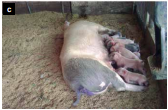Pregnancy and maternity in deep litter systems as an agroecological alternative for pig production, backyard experience
Abstract
The deep litter system in swine production constitutes an alternative for pig rearing at a family level and contributes significantly to reducing pollution to the environment, in addition to being, from the feeding point of view, an economical source of obtaining pigs. tasty and healthy animal protein.
The use of the deep litter system for raising pigs at a family level generates a minimum environmental impact, since it has the goodness of not creating effluents because the litter used acts as an absorbent, considerably reducing odors and the presence of flies. , allowing a rational use of water, as well as animal and human welfare.
It has been pointed out that the gestation of sows in deep litter is possible as long as the litter is properly managed, it is beneficial for the sow from the point of view of air quality, poise, exercises and other positive behaviors, these components of the so-called animal welfare (Pig World, 2012).
References
Cruz, E., R. Almaguel, C. Mederos y C. González. 2009. Sistema de cama profunda en la producción porcina a pequeña escala. [En línea]. Rev. Cient. (Maracaibo) 19:5. Disponible en: http://www.scielo.org.ve/ scielo.php?pid=S079822592009000500009&script =sci_arttext. Consulta: 01-04-14.
Díaz, L. 1994. Sistema deep bedding: Proceso de mayor limpieza y economía para crianza de cerdos [En línea]. Universidad Nacional de Chile. Disponible en: http:/www.ecampo.com/media/news/nl/ganporcinosinstalaciones4.htm. Consulta: 14-12-08.
Faner, C. 2007. Cama profunda en la producción porcina una alternativa a considerar. [En línea]. Instituto Nacional de Tecnología Agropecuaria, INTA, Universidad Nacional de Córdova (Argentina). Disponible en: http:/INTA.gob. ar/mjuarez/info/documentos/ Porcinos/CamaProfunda.pdf. Consulta: 14-12-08.
González, C. 2007. Uso de la cama profunda en cerdos en Venezuela como mecanismo para reducir el Impacto ambiental. [En línea]. Universidad Central de Venezuela. Disponible en: http://www.buenastareas.com/ensayos/Uso-De-La-Cama-ProfundaEn/3795275.html. Consulta: 01-04-14.
López, D., C. González y F. Chacín. 2014. Caracterización de unidades de producción porcina en cama profunda a pequeña escala en Venezuela, utilizando métodos multivariados. Avances en Investigación Agropecuaria 18(1): 67-79 pp.


